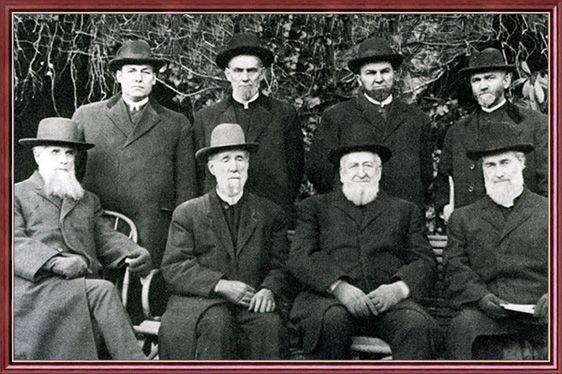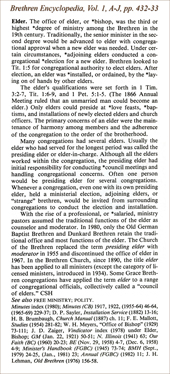


Most articles of The Brethren Encyclopedia share a very similar format. The current sample article involves a tradition that has been phased out of all but a few Brethren congregations: the office of Elder. A century ago it was the Elders who supervised the local congregation, maintained harmony among the membership, and cast the only votes at Annual Meeting. We take an in-depth look at the major components of this article (Vol. 1, A-J, pp. 432-33), including a modest examination of presentation, text format, explanation of symbols, additional references, other BE articles, photographs, and external bibliography. The selection of this article illustrates the timeless nature of information contained in the Brethren Encyclopedia. BE is a common resource for individuals of various theological beliefs and political ideologies. It is a continuing reflection of a developing people called the Brethren.
 CLICK TO ENLARGE |
 CLICK TO ENLARGE |
|
Elder. The office of elder, or *bishop, was the third or highest *degree of ministry among the Brethren in the 19th century. Traditionally, the senior minister in the second degree would be advanced to elder with congregational approval when a new elder was needed. Under certain circumstances, *adjoining elders conducted a congregational *election for a new elder. Brethren looked to Titus 1.5 for congregational authority to elect elders. After election, an elder was *installed, or ordained, by the laying on of hands by other elders. The elder's qualifications were set forth in 1 Timothy 3:2-7, Titus 1:6-9, and 1 Peter 5:1-5. (The 1866 Annual Meeting ruled that an unmarried man could become an elder.) Only elders could preside at *love feasts, *baptisms, and installations of newly elected elders and church officers. The primary concerns of an elder were the maintenance of harmony among members and the adherence of the congregation to the order of the brotherhood. Many congregations had several elders. Usually the elder who had served for the longest period was called the presiding elder or elder-in-charge. Although all the elders worked within the congregation, the presiding elder had initial responsibility for conducting *council meetings and handling congregational concerns. Often one person would be presiding elder for several congregations. Whenever a congregation, even one with its own presiding elder, held a ministerial election, adjoining elders, or “strange” brethren, would be invited from surrounding congregations to conduct the election and installation. With the rise of the professional, or *salaried, ministry pastors assumed the traditional functions of the elder as counselor and moderator. In 1980, only the Old German Baptist Brethren and Dunkard Brethren retain the traditional office and most functions of the elder. The Church of the Brethren replaced the term presiding elder with moderator in 1955 and discontinued the office of elder in 1967. In the Brethren Church, since 1890, the title elder has been applied to all ministers (except the category of licensed ministers, introduced in 1934). Some Grace Brethren congregations have applied the term elder to a range of congregational officials, collectively called a “council of elders.” CSH |
|
See also FREE MINISTRY; POLITY. |
|
Minutes index (1980); Minutes (CB) 1917, 1922, (1944-64) 46-64, (1965-69) 229-37; D. P. Sayler, Installation Service (1882) 13-16; H. B. Brumbaugh, Church Manual (1887) ch. 11; F. E. Mallott, Studies (1954) 281-82; W. H. Meyers, “Office of Bishop” (1929) 73-111; J. D. Zaiger, Vindicator index (1978) under Elder, Bishop; GM (Jan. 22, 1921) 50-51; N. Illinois (1941) 63; Our Faith (BC) (1960) 20-23; BE (Nov. 29, 1958) 4-7, (Dec. 6, 1958) 4-9; Minister's Handbook (FGBC) (1945) 73-74; BMH (Sept., 1979) 24-25, (Jan., 1981) 23; Annual (FGBC) (1982) 11; J. H. Lehman, Old Brethren (1976) 156-58. |
Most articles of The Brethren Encyclopedia do not have photographs, for the resulting work might be more of a pictorial gallery with accompanying subtext than a proper encyclopedia. Pleasingly, readers will find a modest number of photographs and illustrations in comparison to the amount of text which yields a nice balance of visual and textual information. Someone has said that 95% of what a sighted person learns comes through their eyes. Another has similarly stated: “One picture is worth a thousand words.” For example, we easily remember the Annual Meeting or Annual Conference facilities of just a few years ago, but can we just as easily recall the issues of business of that same gathering? Photographs give us the opportunity to make visual clues and retain much that would require an enormous amount of text. Photographs of The Brethren Encyclopedia are nicely selected according to the different Brethren bodies represented, and the span of history that is involved.
Contributing authors are indicated by their initials at the end of the article's main body text. Full names may then be located in the Author List which appears in Volume I, starting on page xiii. The initials of CSH stand for Cathy Simmons Huffman, who composed the article on Elders. The Author List is naturally alphabetized, but, grouped by the last names. This can be slightly confusing since these codes start with the initial of the first name. In other words, CSH does not appear on page xiv under the C group, but rather on page xxi in the H grouping. A bold letter as a heading for each group would have been helpful. No extensive information is given about each author other than the city and state of their residence at the time of publication. In the interest of privacy we have omitted that portion concerning CSH.
Subject titles or names appear in bold (Elder). In the case of a person, the year of birth and death are given when known, followed by a brief label that captures the essence of their life contribution, occupation, or accomplishments, such as preacher, historian, lecturer, or author. In the case of a group (such as Elders), the first two paragraphs usually explain the purpose of the group, what they represent, or their importance with regard to the Brethren movement. Articles represent the full spectrum of length. A few span two and three full pages, while some comprise a minor section of one column, and the length of many others is everything in between.
One particular that contributes to the length of any given article is the fact that the story must be retold in regard to each Brethren body. The experience of the Church of the Brethren may be slightly or greatly different than that of The Brethren Church. The Grace Brethren may have a history that is different than the Dunkard Brethren, or the Old Order bodies. It is no small task for an author to write an extensive article and still maintain a fair and balanced perspective that will be pleasing to each group. To further assist the reader, symbols are used throughout many articles to indicate pertinent information that may be found in other BE articles. For example, in the current sample article concerning Elders, notice the asterisk ( * ) appearing before the words Bishop, Degree of ministry, Adjoining elders, Election and a few others. This indicates the existence of a separate BE article which has some degree of relevance. This is extremely helpful in cross-referencing material.
Other BE articles related to the current article can enhance one's understanding of the greater subjects at hand, and which have related information that would augment a more exhaustive study of the person, subject, or theme of an article. Serious researchers will delight in this opportunity for cross-referencing. Our feature article has two: Free Ministry and Polity. In the interest of brevity, we shall cite only the most relevant passages of each article because both recommended articles are very large, especially Polity.
FREE MINISTRY
..."Advocates of the free ministry point to the practice of the early church and the *Anabaptist movement and note the New Testament instruction to ordain elders (plural) in every church (Acts 14:23)..."; BE, Vol. I, A-J, p. 513.
POLITY
..."The preaching elders formed a Standing Committee to organize queries (questions) which were submitted and to recommend church policy or order in these matters, to be decided by the total assembly"; BE, Vol. II, K-Z, p. 1042.
It would be expected that one may ask: “How does this section differ from the related articles indicated by an asterisk in the body of the article itself?” There are nine (9) asterisks referencing other BE articles but only two articles are found in the See Also section, and, neither of the latter two appear in the article itself, nor, do the nine others appear in See Also. This component may be regarded as more of a recommendation that will yield a greater understanding of the subject. For example, Baptism is referenced in the main article by an asterisk. The Baptism article mentions the participation of an Elder at baptisms but doesn't tell you a lot about the office of the Elder, whereas the See Also recommendation of Free Ministry is more focused on the broader subject of ministry and the role of the Elder in the congregation.
A bibliography accompanies most articles. Some are rather scant at one or two lines, while others are five or six lines. Personages or memorable events tend to garner the most references. This sample article had a bibliography of ten lines comprising fifteen external sources. The format of each entry is: name of source in italics, year of issue, and list of pages. For example [F. E. Mallott, Studies (1954) 281-82] refers to Floyd Elwood Mallott (former professor at Bethany Theological Seminary), who wrote a book titled Studies in Brethren History, which was published in 1954, and the correlation to Elders will be found on Pages 281-282.
HOME :
ABOUT BE :
SAMPLE :
PHOTOGRAPHS :
HISTORY :
ILLUSTRATIONS :
OPPORTUNITY
Expressed written permission granted to Church of the Brethren Network by
Brethren Encyclopedia, Inc., 313 Fairview Avenue, Ambler, PA 19002
Graphic reproductions, Copyright, BEI 1983, COB-NET 2003
All rights reserved